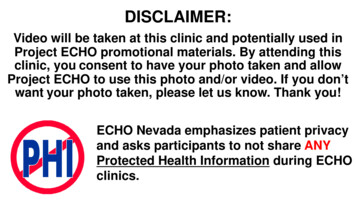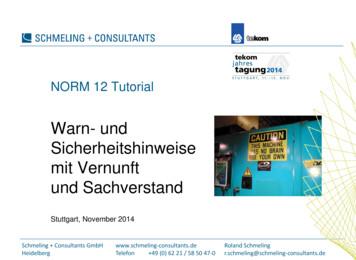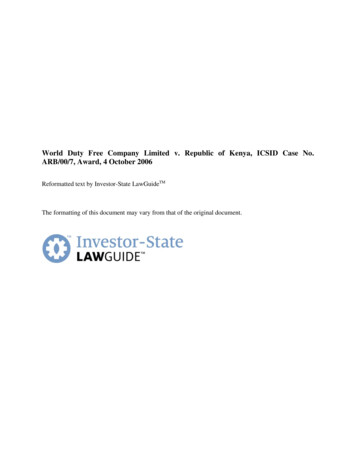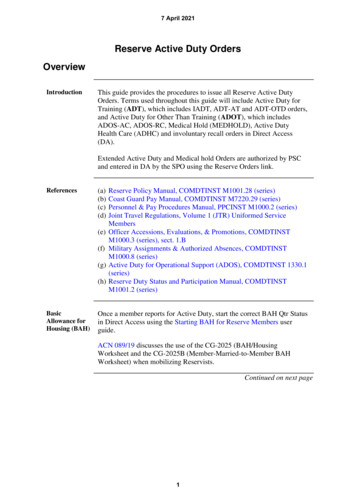
Transcription
DISCLAIMER:Video will be taken at this clinic and potentially used inProject ECHO promotional materials. By attending thisclinic, you consent to have your photo taken and allowProject ECHO to use this photo and/or video. If you don’twant your photo taken, please let us know. Thank you!ECHO Nevada emphasizes patient privacyand asks participants to not share ANYProtected Health Information during ECHOclinics.
DUTY TO WARNJOSHUA FITZGERALD, M.D.UNR-MED PSYCHIATRY AND BEHAVIORAL SCIENCES
HISTORY – TARASOFF V. REGENTS OFUNIVERSITY OF CALIFORNIA On October 27, 1969 Tatiana Tarasoff was killed by Prosenjit Poddar. Poddar had been treated by Dr. Lawrence Moore, a psychologist with CowellMemorial Hospital at the University of California, Berkeley Two months prior to Tarasoff’s death, Poddar had endorsed thoughts and plan to killTarasoff. Poddar was diagnosed with a “paranoid schizophrenic reaction.” Police were called and Poddar was detained for only a short time and evaluated by2 psychiatrists.
HISTORY – TARASOFF V. REGENTS OFUNIVERSITY OF CALIFORNIA After Poddar’s release, Moore’s superiors instructed him to take no furtheraction in detaining Poddar. Poddar plead not guilty by reason of insanity at his criminal trial He was charged with second degree murder, but this was changed tomanslaughter by the Court of Appeals. His conviction was later reversed bythe California Supreme Court
HISTORY – TARASOFF V. REGENTS OFUNIVERSITY OF CALIFORNIA Tarasoff’s family sued the psychiatrists and police claiming that there was a“failure to detain a dangerous patient,”; “failure to warn on a dangerouspatient,”; “abandonment of a Dangerous Patient,”; and "Breach of PrimaryDuty to Patient and the Public." They also claimed that the therapists failed to protect Tatiana. This set up for the Tarasoff Rule and Duty to Warn for other states. There is no federal law to direct duty to warn, but is determined by individualstates.
NEVADA’S VERSION: NRS 629.550 DUTY OF MENTAL HEALTH PROFESSIONALS CONCERNING CERTAINTHREATS “NRS629.550 Duty to apply for emergency admission to mental healthfacility of patient who communicates certain threats or to makereasonable effort to timely communicate threats to certain persons; civil orcriminal liability or disciplinary action.”
NRS 629.550 “1. If a patient communicates to a mental health professional an explicit threat of imminentserious physical harm or death to a clearly identified or identifiable person and, in thejudgment of the mental health professional, the patient has the intent and ability to carry outthe threat, the mental health professional shall apply for the emergency admission of thepatient to a mental health facility pursuant to NRS 433A.160 or make a reasonable effort tocommunicate the threat in a timely manner to:(a) The person who is the subject of the threat;(b) The law enforcement agency with the closest physical location to the residence of theperson; and(c) If the person is a minor, the parent or guardian of the person. “
NRS 629.550 “2. A mental health professional shall be deemed to have made areasonable effort to communicate a threat pursuant to subsection 1 if: (a) The mental health professional actually communicates the threat in atimely manner; or (b) The mental health professional makes a good faith attempt tocommunicate the threat in a timely manner and the failure to actuallycommunicate the threat in a timely manner does not result from the negligenceor recklessness of the mental health professional.”
NRS 629.550 “3. A mental health professional who exercises reasonable care indetermining that he or she: (a) Has a duty to take an action described in subsection 1 is not subject tocivil or criminal liability or disciplinary action by a professional licensingboard for disclosing confidential or privileged information. (b) Does not have a duty to take an action described in subsection 1 isnot subject to civil or criminal liability or disciplinary action by a professionallicensing board for any damages caused by the actions of a patient.”
NRS 629.550 “4. The provisions of this section do not:(a) Limit or affect the duty of the mental health professional to reportchild abuse or neglect pursuant to NRS 432B.220; or (b) Modify any duty of a mental health professional to take precautionsto prevent harm by a patient: (1) Who is in the custody of a hospital or other facility where themental health professional is employed; or (2) Who is being discharged from such a facility.”
NRS 629.550 “5.As used in this section, “mental health professional” includes:(a) A physician or psychiatrist licensed to practice medicine in this State pursuant to chapter630 or 633 of NRS;(b) A psychologist who is licensed to practice psychology pursuant to chapter 641 of NRS;(c) A social worker who:(1) Holds a master’s degree in social work;(2) Is licensed as a clinical social worker pursuant to chapter 641B of NRS; and(3) Is employed by the Division of Public and Behavioral Health of the Department ofHealth and Human Services;”
NRS 629.550 “(d) A registered nurse who:(1) Is licensed to practice professional nursing pursuant to chapter632 of NRS; and(2) Holds a master’s degree in psychiatric nursing or a related field;(e) A marriage and family therapist licensed pursuant to chapter641A of NRS;(f) A clinical professional counselor licensed pursuant to chapter 641A ofNRS; and”
NRS 629.550 “(g) A person who is working in this State within the scope of his or her employment by the FederalGovernment, including, without limitation, employment with the Department of Veterans Affairs, themilitary or the Indian Health Service, and is: (1) Licensed or certified as a physician, psychologist, marriage and family therapist, clinicalprofessional counselor, alcohol and drug abuse counselor or clinical alcohol and drug abuse counselor inanother state; (2) Licensed as a social worker in another state and holds a master’s degree in social work; or (3) Licensed to practice professional nursing in another state and holds a master’s degree inpsychiatric nursing or a related field.(Added to NRS by 2015, 1551, 1817) “
REFERENCES SCOCAL, Tarasoff v. Regents of University of California , 17 Cal.3d 425 available regents-university-california-30278)(last visited Tuesday September 5, 2017). The Impact of Social Science Evidence in Predicting Dangerousness and establishing aDuty to warn, Cornell University Law School: available dent projects/DutytoWarn.html) (lastvisited Tuesday September 5, 2017) Nevada Revised Statues, CHAPTER 629 - HEALING ARTS GENERALLY, available RS629Sec550) (last visitedTuesday September 5, 2017)
(3) Licensed to practice professional nursing in another state and holds a master’s degree in psychiatric nursing or a related field. (Added to NRS by 2015, 1551, 1817) “











